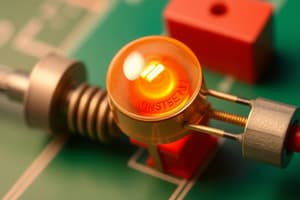Podcast
Questions and Answers
What relationship does Ohm's Law describe?
What relationship does Ohm's Law describe?
- The relationship between voltage and resistance
- The relationship between voltage and power
- The relationship between current and voltage (correct)
- The relationship between current and resistance
What is the unit of resistance according to Ohm's Law?
What is the unit of resistance according to Ohm's Law?
- Ohm (correct)
- Volt
- Ampere
- Watt
What happens to the current if the resistance is doubled?
What happens to the current if the resistance is doubled?
- It remains the same
- It quadruples
- It doubles
- It gets halved (correct)
What is a rheostat used for in an electric circuit?
What is a rheostat used for in an electric circuit?
Which equation represents Ohm's Law?
Which equation represents Ohm's Law?
If the potential difference across a conductor is 1 V and the current is 1 A, what is the resistance?
If the potential difference across a conductor is 1 V and the current is 1 A, what is the resistance?
The V-I graph for a nichrome wire shows what type of relationship?
The V-I graph for a nichrome wire shows what type of relationship?
What does the equation $V/I=constant$ signify in terms of resistance?
What does the equation $V/I=constant$ signify in terms of resistance?
Flashcards
What is Ohm's Law?
What is Ohm's Law?
Ohm's Law states that the current flowing through a conductor is directly proportional to the voltage applied across its ends, provided the temperature and other physical conditions remain constant.
What is the unit of resistance?
What is the unit of resistance?
The unit of resistance is the ohm, represented by the Greek letter omega (Ω).
What happens to the current when resistance doubles?
What happens to the current when resistance doubles?
If the resistance is doubled, the current is halved, assuming voltage remains constant.
What is a rheostat?
What is a rheostat?
Signup and view all the flashcards
What is the equation for Ohm's Law?
What is the equation for Ohm's Law?
Signup and view all the flashcards
If the potential difference is 1 V and the current is 1 A, what is the resistance?
If the potential difference is 1 V and the current is 1 A, what is the resistance?
Signup and view all the flashcards
What kind of relationship does the V-I graph for a nichrome wire show?
What kind of relationship does the V-I graph for a nichrome wire show?
Signup and view all the flashcards
What does the equation V/I = constant signify in terms of resistance?
What does the equation V/I = constant signify in terms of resistance?
Signup and view all the flashcards
Study Notes
Circuit Setup
- Components required: nichrome wire, torch bulb, 10 W bulb, ammeter (0-5 A range), plug key, and connecting wires.
- Four dry cells (1.5 V each) connected in series with the ammeter, creating a gap in the circuit.
Ohm's Law
- Voltage-Current (V-I) graph of a nichrome wire shows a straight line, indicating a linear relationship between current and potential difference.
- Observations confirm that V/I remains consistent, represented by a straight line through the origin on the graph.
Historical Context
- Georg Simon Ohm discovered the relationship between current (I) and potential difference (V) in 1827.
- Ohm's Law states that V is directly proportional to I for a metallic wire, given constant temperature.
Mathematical Relationships
- Ohm's Law can be expressed as:
- ( V/I = constant )
- ( V = IR )
- Resistance (R) is defined as the constant ratio for a given metallic wire at a specific temperature.
Resistance Definition
- Resistance is the property of a conductor to impede the flow of electric charge, measured in ohms (Ω).
- 1 V across a conductor with 1 A current results in a resistance of 1 Ω.
Current and Resistance Relation
- From the equation ( I = V/R ), current through a resistor is inversely proportional to its resistance.
- Doubling the resistance results in halving the current.
Variable Resistance
- A rheostat is used in circuits to adjust resistance without altering the voltage source, thereby regulating current flow in practical applications.
Studying That Suits You
Use AI to generate personalized quizzes and flashcards to suit your learning preferences.




